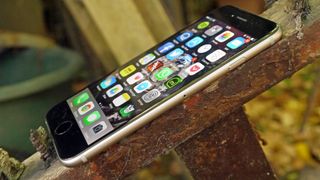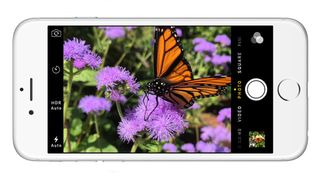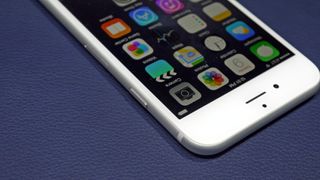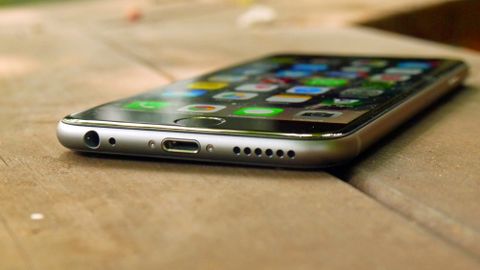Why you can trust TechRadar
The important features of the Apple iPhone 6 are hard to list. On the one hand there are so many of them that I don't really know where to start, but on the other hand the iPhone 6 is very much an iteration of a long line of Apple smartphones, and shares a lot of features with previous smartphones.
However, there are some standout additions that I want to talk about.
Screen
The screen of the iPhone 6 is definitely an upgrade from before – you can't increase the size, resolution, colour reproduction and power efficiency without calling it an improvement.
The resolution on offer is 1334 x 750, which is a change from the 1136 x 640 resolution of previous iPhones. Thanks to being increased to 4.7 inches though it's still 326 PPI, which means you'll get a very familiar experience visually.
My technology reviewer hat wants to criticise Apple for not going Full HD with the display here, let alone QHD like the Samsung Galaxy S7, but when I first picked up the iPhone 6 I wasn't sure if it was a real or dummy device, such was the closeness of the display to the glass.

The improved contrast ratio (the difference between the deepest blacks and the whitest whites) is really something to behold, and the colour reproduction is very impressive too. It's not in the same league as the Samsung Galaxy S7's Super AMOLED screen, but then again a lot of people feel that screen is too saturated in colour.
It's worth noting that Apple has stuck with the exact same screen for the iPhone 6S - and even the iPhone 7. The latest iPhone might have 3D Touch pressure-sensing technology stashed within, but the picture is nigh-on identical to its predecessor. In that sense, the iPhone 6 screen remains as good as it gets at this size.
In terms of a more scientific approach, DisplayMate has conducted in-depth tests of the iPhone 6 and iPhone 6 Plus displays, comparing them to the smaller previous model – and there's good news and bad news here for prospective iPhone 6 buyers.
The good news is that the iPhone 6 is a big step forward on the iPhone 5S. The screen is more correct when it comes to colour reproduction, and as mentioned the contrast ratio (which is important for the more atmospheric movies) is improved, as I noticed in the original TechRadar tests.
However, here's the bad news: despite their similarities, the iPhone 7 has a much better screen, with DisplayMate noting that it is "by far the best performing LCD that we have ever tested".
The iPhone 6 hits the marks when it comes to day to day use, but if you're after better resolution, brightness or more intense colour reproduction, there are better options on the market, with better tech.
As such, I'm not going to give Apple a pass here for that lower-resolution screen. Why are we looking at what is essentially a 720p screen when as far back as 2013 we were seeing smartphones using a Full HD display at the same size?
Okay, so arguments can be made that it saves battery, and that the increase in sharpness is imperceptible at this size. And they're not incorrect statements. It's a great-looking display, and if you've got fewer pixels to drive then the battery will hold out longer.
Rivals such as the now-defunct Samsung Galaxy Alpha and the Sony Xperia Z5 Compact both offer similar dimensions, and are also at the same resolution, meaning there's been some of the same thinking here by other brands in terms of the lower pixel density.
But there's a cost reduction associated – the Z5 Compact in particular – where Apple is sitting pretty at the top of the pile when it comes to price.
The difference in sharpness is visible when the iPhone 6 is held next to a 1080p device, let alone a QHD one. Something like the HTC 10 or LG V20 has sharper, crisper text, and the movie-watching experience is definitely superior.
You might argue that people won't compare the Apple iPhone 6 with a Full HD display, but of course they will: the iPhone 6 Plus has one, and most people will hold both in their hands before deciding which to choose.
I wouldn't disparage a phone for not having the best spec if it wasn't warranted, but for Apple to launch a flagship without packing the best screen technology possible seems a little unfair.
There's a clear lack of clarity in the crispness of the text and images, especially when browsing the web, and while you probably won't miss it much when solely using the iPhone thanks to the enhanced screen technology, I can't see a reason for Apple not sticking in an amazing screen here.
This issue has arguably only gotten worse with the iPhone 6S, but let's not kid ourselves – it was a big enough drag with the launch of the iPhone 6.
Battery life or design can be the only real problem here – and if it's the former, then Apple should be having a long, hard look at its OS to find out why it can't handle a Full HD screen when competitors were managing it ages ago, and are now moving on to QHD displays.
If it's the latter, then the thickness could have easily been increased by a millimetre to accommodate, and it wouldn't have bothered anyone – just look at the 2mm-thicker iPhone 6S for evidence of that.
Camera upgrades
I'll be giving this a lot more focus (I thank you) later on in the review, but for now it's important to really see what Apple is offering from a top-level perspective given that it's stuck once more with an 8MP sensor.
This is a bold move in my eyes when rivals like Samsung and Sony are pushing harder and harder with improved megapixel counts, almost hitting 21MP. So, on the face of it, it seems that Apple was woefully behind the competition, even at the time of the iPhone 6's launch in late 2014.

However, regular readers will know that I'm firmly in the camp of quality over megapixel numbers, and while the rivals' snappers are very good indeed, there's no reason to think that decent pictures can't be grabbed from even a 5MP sensor – after all, that's still good enough to fill a Full HD TV.
So what's Apple done here? Well, the main talking point is Focus Pixels, additional elements that work out where light is actually coming from, so they can provide directional information to the camera to focus more quickly.
This, combined with the lower MP count (which makes the task of taking a photo less onerous for the sensor) improves snapping speed.
However, that's in theory. I didn't notice anything particularly speedy in taking rapid pictures (not counting burst mode) but the additional time did seem to result in well-focused pictures.
Apple's still got the Auto HDR mode on offer here as well, which means a larger selection of your photos will look better naturally. There are also new camera modes to play with, with HD panoramas and a new timelapse feature that's integrated into the app itself.
I feel annoyed at myself for getting excited about the new timelapse feature, testing it out the first day I got my hands on the phone – in reality, it's been on offer for a long time through standalone apps in the App Store, so it shouldn't be something to be lauded.
It's okay as a feature too. I can't see when you'd really need it, and you do need to keep the phone plugged in and ideally on a tripod, but it's not a bad thing to have, and performs well if you've always wondered what the dawn breaking outside your bedroom window looks like (spoiler: it's pitch black for most of it).
It should be pointed out that the iPhone 6 doesn't get the new Live Photos feature introduced with the iPhone 6S, even with the shift to iOS 9. I can't say I'm too bothered though – Apple's automated three-second videos have proven to be a nice gimmick, but nothing more at this stage.
The other element that's been improved on the iPhone 6 camera is the video: Slo-Mo now can pump out 240 frames per second for smoother super-slow movies, and 1080p standard video is now shot at a very smooth 60fps.
Both of these upgrades actually give that 'hyper real' effect that some movies have exhibited at your local multiplex in recent years (there's the Hobbit films, and, er…) and while I really like the way it looks on the phone screen, there will be some that think it's too much.
I'd agree with that for a cinematic shot, but for home videos I think it really adds a touch of class.
Facetime HD camera
The smartphone self-portrait craze shows no signs of going anywhere, and Apple has joined the contest to make people think it has made the ultimate 'selfie' phone.
It makes me sadder every time I write that word.

Again, I'll dig further into this new feature later in the review, but it's definitely a much better front-facing camera, and comes with the features I'd be looking for if I was into taking loads of photos of my face.
For instance, the f/2.2 aperture ratio of the 1.2MP camera is pretty darn good, and helps to capture good photos in low light. On top of that you've got an HDR mode for snaps and video, which appears to fire automatically, as there's no option to toggle it from within the app itself.
And there are the lovely pre-shot filters to have a look at as well, so if taking a picture of yourself isn't enough, you can always make it look weirder.
However, it's not got the resolution power of some of the other handsets on the market – the HTC One M9, for instance, has a much better front-facing camera, and the Samsung Galaxy Note 4 even incorporates a panorama mode for the self-portrait lovers.
I'm not saying this is critical technology, but if you're one to buy a phone for the pictures you can take of yourself, there are better options out there.
Apple Watch
Okay, it's not really a key feature, as the Watch is basically just another screen for a device that's already a bit smaller than what's on the market.
But the iPhone 6 was the first device to actively tie in with the Apple Watch, and since the launch of iOS 8.2, you've had the Watch app on your phone whether you like it or not.

At least U2 didn't come around to your house to announce that one.
The Apple Watch isn't cheap though, as prices range from $350 (£299, AU$499) for the entry-level Sport model to $17,000 (£13,500, AU$24,000) for the top-tier 18-karat gold editions.
Funnily enough, the Apple Watch 2 takes a much safer approach to pricing. It starts at $269 and works its way up to $1,049.
The Watch also really needs to be paired with the iPhone 6 or later for the best experience, with the GPS added into the mix when running, as it's not present on the wrist-dweller.
The Apple Watch isn't an essential accessory, but if you're desperate for a smartwatch it shouldn't disappoint. It's stylish, and it gives you easier access to your notifications – if you're a compulsive smartphone-checker it could help rid you of your addiction.
Current page: Key features
Prev Page Introduction and design Next Page Apple Pay, M8 co-processor and improved keyboard
Gareth has been part of the consumer technology world in a career spanning three decades. He started life as a staff writer on the fledgling TechRadar, and has grown with the site (primarily as phones, tablets and wearables editor) until becoming Global Editor in Chief in 2018. Gareth has written over 4,000 articles for TechRadar, has contributed expert insight to a number of other publications, chaired panels on zeitgeist technologies, presented at the Gadget Show Live as well as representing the brand on TV and radio for multiple channels including Sky, BBC, ITV and Al-Jazeera. Passionate about fitness, he can bore anyone rigid about stress management, sleep tracking, heart rate variance as well as bemoaning something about the latest iPhone, Galaxy or OLED TV.

Nikon Z 40mm f/2 review: this cheap, modern 'nifty forty' has been my every day lens for over a year and it hasn't let me down

Could ChatGPT be the next big cybersecurity worry — researchers say it can crack systems faster than ever before

Meta Quest's software is coming to new Asus ROG and Lenovo headsets
